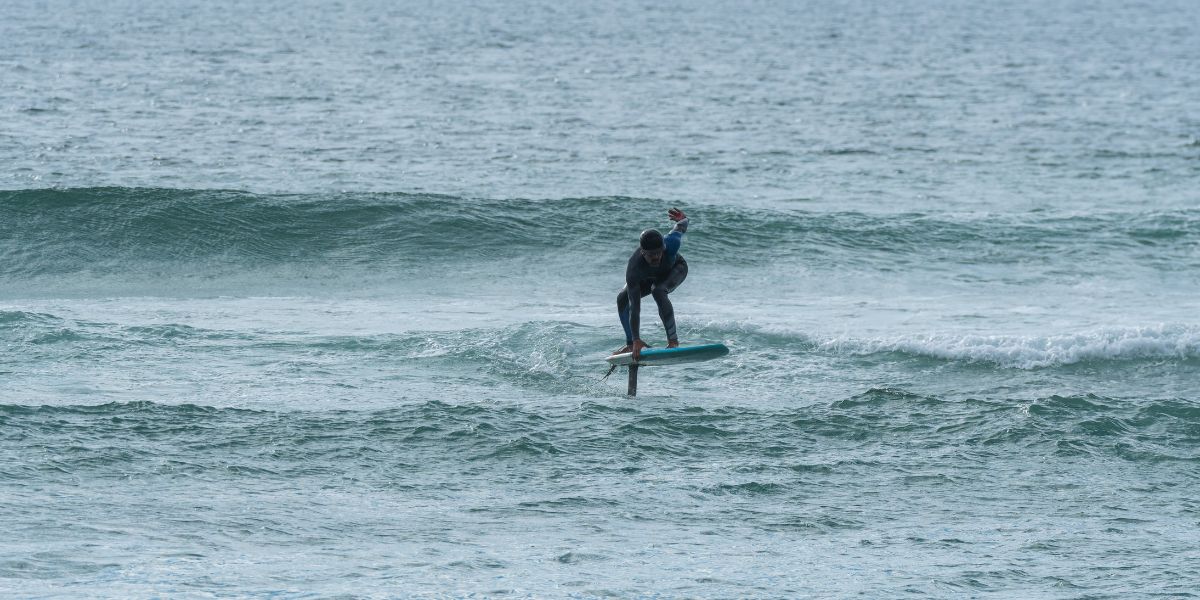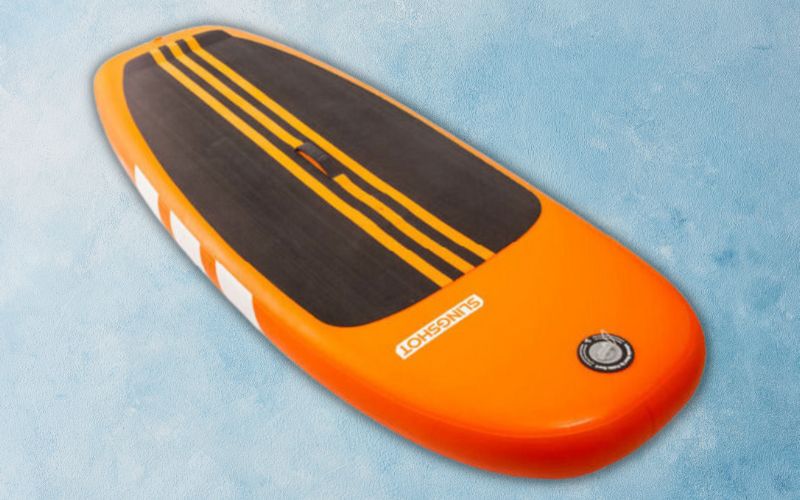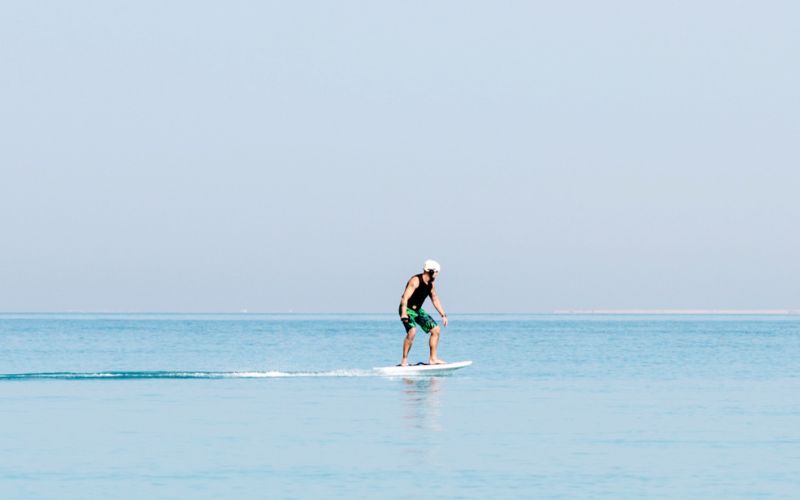An inflatable foil board is an inflatable surfboard that has a ‘foil’ attached to the bottom, extending below the water’s surface. The foil acts instead of the traditional fins, lifting the surfboard out of the water and letting you build up some wicked speeds.
Not all foil surfboards are inflatable, but some are – and if you want to try wing foil surfing then they come with a separate part that is often inflatable too. Let’s take a look at everything you need to know about foil surfing in general, and whether inflatable foil boards are worth your money.

How does foil surfing work?
Foil surfing is a relatively new sport and so not a lot of people fully understand how they work – but it’s really quite clever.
The board contains a wing-like foil underneath it, which functions the same way as an airplane wing. This means that it creates areas of high and low pressure. When you stand on the board, the wings on the foil deflect water pressure downwards.
This downward pressure pushes the board and its rider above the water. At the same time, the wave propels the rider forward.
What this means is that you’re essentially surfing above the waves, which in itself is quite the rush. But the pressures involved also mean that you can build up rapid speed even in waves that would normally not offer much excitement at all.
Benefits of an inflatable foil board
Not all foil boards are inflatable – many are solid. But an inflatable surfboard has the advantage of being more lightweight for storage. You only need to inflate it once you reach the beach, and you’re ready to go.
These aren’t made from the same kind of materials as inflatables used on land, but instead from durable rubber – the kind used for inflatable speedboats. You aren’t buying a substandard inflatable that will pop the first time you use it – but you’re also not buying something cheap.
Foil surfing, especially wing foil surfing, involves more equipment than regular surfing since you need the mast and foil, and the optional wing. So anything you can do to cut down on carrying weight and storage space is useful – which is why inflatable foil boards are popular.
There are no drawbacks to using an inflatable board for foil surfing, so they are definitely a good option to consider.

How to surf with an inflatable foil board
The first thing you need to do is identify an ideal spot to surf. Ideally, you should go for a site that isn’t crowded, especially if you’re a beginner. This is because foil boards can potentially injure you or others.
It sounds scary, but the foil’s fins may slice a person’s leg open. Despite this being very rare, the potential threat was enough to make the government of France place restrictions on hydrofoils.
The good thing about these boards is that you can make the best of whatever situation/place you’re in. This is because you don’t need strong waves to propel you.
It’s actually best to go for an area with fewer waves, especially if you are a beginner.
When it comes to foil surfing, the aim is to paddle into whitewater rollers and then stand up to have enough power to ride the inflatable foil board.
So, the key is to find the perfect spot on the board, which usually means having your back foot over the mast or slightly behind it. If you want to begin pumping or create a tight radius turn, take a small step back and you’ll be able to alter your course using a lot of pressure on the front foot.
Initiate paddling out when you’re in chest-deep water, just like you would on a regular board. Duck diving is surprisingly simple because inflatable foil boards provide extra lift and propel you through the wave.

Why is foil surfing popular?
As a surfer, you do not have the luxury of surfing sound waves every day. There are weeks of flatness, as well as periods when there’s no wind.
The best thing about inflatable foil surfing is that you don’t need epic waves or strong winds. The inflatable foil board helps to lift you out of the water and reduces all drag.
You only need a slight wave to propel you forward, and the inflatable foil board will carry you much further than a standard surfboard would. In bigger surf, and especially when going downwind, inflatable foil rides can be epic.
At first glance, these boards might appear difficult to ride, but if you’re an experienced surfer then the transition isn’t too difficult – although becoming a master of foil surfing means unlearning some of your muscle memory from regular surfing.
The speed you can achieve, even on minor waves, is incredible. Fly through close-out sections and even use your speed to pump to the next wave or breaking section.
The drawbacks of foil surfing
There are a few downsides to foil surfing compared to regular surfing, which you need to consider:
- As inflatable foil surfing becomes more popular, there is growing concern about the dangers for riders and those in the water due to how sharp the fins are on the foil.
- Inflatable foil boards have more surface resistance, making the ride less smooth when the rider goes up and down.
- An inflatable foil board cannot balance without the foil on.
- Inflatable foil boards need to be pumped up, which can be tiring if you’re using a manual pump.

Is it challenging to ride an inflatable foil board?
Although inflatable foiling is a relatively new sport, it’s only as difficult to learn as regular surfing. It just involves different body movements. If you’re someone who has tried surfing before, foil surfing is something you should be able to adapt to.
A lot of it is confidence – being brave enough to stand up and try it properly. If you don’t make the movements confidently then more often than not you’ll wipe out.
A beginner should look for foils that don’t require a lot of speed to attain buoyancy. A taller mast, 70 centimetres or more, is ideal for learning because it provides the necessary height and prevents pearling in choppy waters. You should also choose a larger board. It’ll be harder to navigate but more forgiving for your mistakes.
As you advance, you’ll be able to switch to a smaller, more mobile inflatable board. But if you’re a seasoned water sports enthusiast, you might be able to get started with a slightly smaller inflatable board. Many professional surfers use inflatable foil surfboards with less volume.
What is wing foil surfing?
Wing foil surfing is the same as foil surfing but with an added wing, which can be a thin solid kite-style material or an inflatable. It’s equivalent to kite surfing – you use the wing for extra uplift and speed.
Wing foil surfing is definitely something to work up to, but once you’re a confident foil surfer then it’s an exciting option to have. Just be aware that if you choose an inflatable wing and an inflatable board, that’s two large inflatables that you need to pump up before you get started. Although again, storage of inflatable wings is much easier.
Final thoughts
One of the latest and most exciting extreme sports is foil surfing, and an inflatable foil board is a great option for both beginners and experienced surfers.
If you’re interested in giving foil surfing or wing foil surfing a try, an inflatable board will be easier for you to transport and store, without any drawbacks compared to a solid board. Have fun trying, but make sure to take your time as you get used to the thrill!
